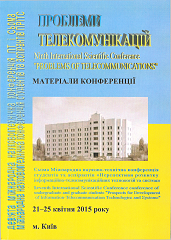ПЕРСПЕКТИВИ ВИКОРИСТАННЯ ТЕХНОЛОГІЇ PON ДЛЯ ПЕРЕДАВАННЯ СИГНАЛІВ ТОЧНОЇ ЧАСТОТИ
Анотація
Prospects of using PON technology for
transmission of signals exact frequency and time
Considered technology PON, principles of its work and a summary of the types of technology and the prospects of its use as telecommunications distribution network signals exact frequency.
Посилання
Бірюков М.Л., Стеклов В.К., Костік Б.Я. Транспортні мережі телекомунікацій: Системи мультиплексування: Підручник для студентів вищ. техн. закладів; За ред. В.К. Стеклова. – К.: Техніка, 2005. – 312 с., іл.
ITU-T Recommendation G.987.1 (01/10) 10-Gigabit-capable passive optical networks. (XG-PON): General requirements.
ITU-T Recommendation G.989.1 (03/13) 40-Gigabit-capable passive optical networks. (NG-PON2): General requirements.
PON – оптичекие сети с пассивной оптической магистралью [Електронний ресурс]. Режим доступу до ресурсу: http://deps.ua/.
Всеукраинский проект UA.PON [Електронний ресурс]. Режим доступу:
##submission.downloads##
Як цитувати
Номер
Розділ
Ліцензія
Авторське право (c) 2017 Анатолій Петрович Дяченко, Микола Леонідович Бірюков

Ця робота ліцензується відповідно до Creative Commons Attribution 4.0 International License.
Authors who submit to this conference agree to the following terms:a) Authors retain copyright over their work, while allowing the conference to place this unpublished work under a Creative Commons Attribution License, which allows others to freely access, use, and share the work, with an acknowledgement of the work's authorship and its initial presentation at this conference.
b) Authors are able to waive the terms of the CC license and enter into separate, additional contractual arrangements for the non-exclusive distribution and subsequent publication of this work (e.g., publish a revised version in a journal, post it to an institutional repository or publish it in a book), with an acknowledgement of its initial presentation at this conference.
c) In addition, authors are encouraged to post and share their work online (e.g., in institutional repositories or on their website) at any point before and after the conference.

